Multiplying Two Binomials Using the FOIL Method
FOIL (the acronym for first, outer, inner and last) method is an efficient way of remembering how to multiply two binomials in a very organized manner.
The word FOIL is an acronym that stands for
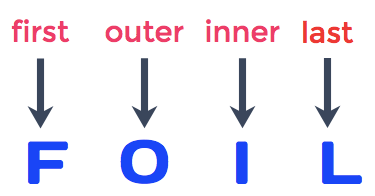
- The first means that we multiply the terms which occur in the first position of each binomial.
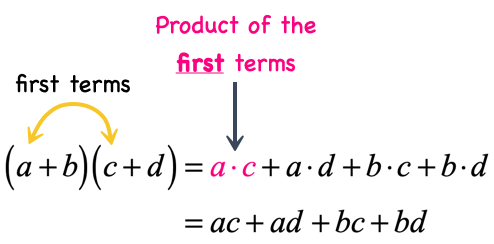
- The outer means that we multiply the terms which are located in both ends (outermost) of the two binomials when written side-by-side.
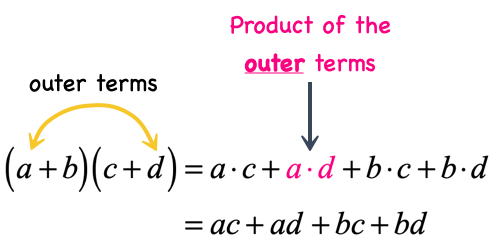
- The inner means that we multiply the middle two terms of the binomials when written side-by-side.
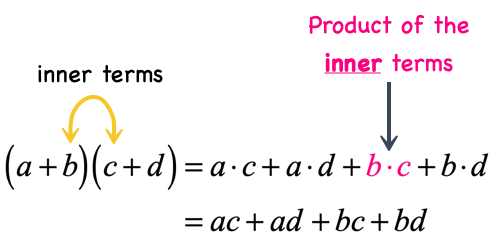
- The last means that we multiply the terms which occur in the last position of each binomial.
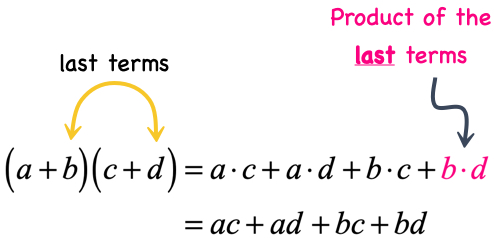
- After obtaining the four (4) partial products coming from the first, outer, inner and last, we simply add them together to get the final answer.
Examples of How to Multiply Binomials using the FOIL Method
Example 1: Multiply the binomials [latex]\left( {x + 5} \right)\left( {x – 3} \right)[/latex] using the FOIL Method.
- Multiply the pair of terms coming from the first position of each binomial.
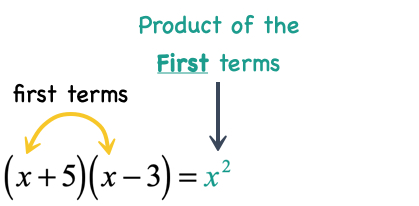
- Multiply the outer terms when the two binomials are written side-by-side.
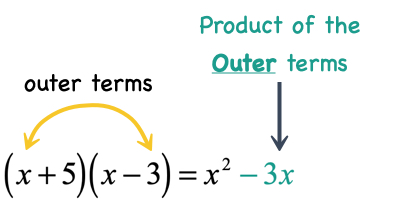
- Multiply the inner terms when the two binomials are written side-by-side.
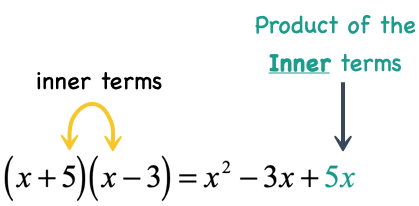
- Multiply the pair of terms coming from the last position of each binomial.
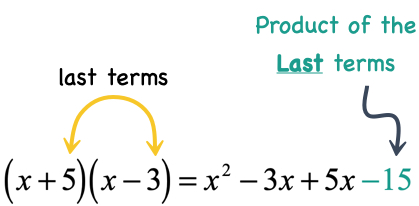
- Finally, simplify by combining like terms. I see that we can combine the two middle terms with variable [latex]x[/latex].

Example 2: Multiply the binomials [latex]\left( {3x – 7} \right)\left( {2x + 1} \right)[/latex] using the FOIL Method.
If the first presentation on how to multiply binomials using FOIL doesn’t make sense yet. Let me show a different way. The idea is to expose you to different ways on how to address the same type of problem with a different approach.
- Multiply the first terms

- Multiply the outer terms

- Multiply the inner terms

- Multiply the last terms

After applying the FOIL, we arrive at this polynomial which we can simplify by combining similar terms. The two middle [latex]x[/latex]-terms can be subtracted to get a single value.
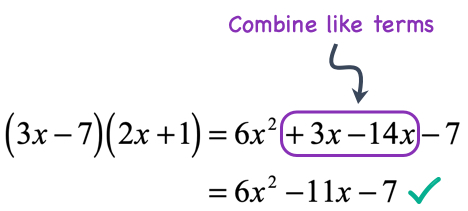
Example 3: Multiply the binomials [latex]\left( { – \,4x + 5} \right)\left( {x + 1} \right)[/latex] using the FOIL Method.
Another way of doing this is to list the four partial products, and then add them together to get the answer.
- Multiply the first terms

- Multiply the outer terms

- Multiply the inner terms

- Multiply the last terms

Get the sum of the partial products, and then combine similar terms.
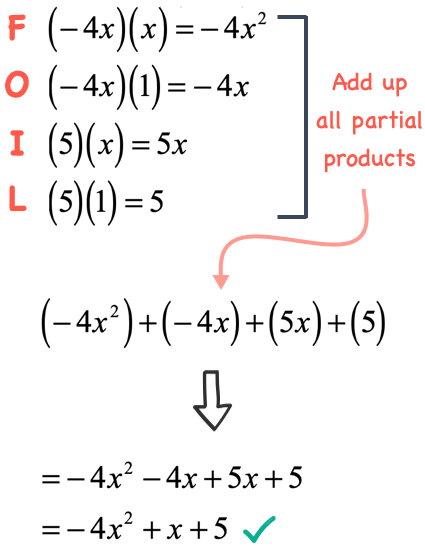
Example 4: Multiply the binomials [latex]\left( { – \,7x – 3} \right)\left( { – \,2x + 8} \right)[/latex] using the FOIL Method.
Solution:
- Multiply the first terms

- Multiply the outer terms

- Multiply the inner terms

- Multiply the last terms

Finally, combine like terms to finish this off!
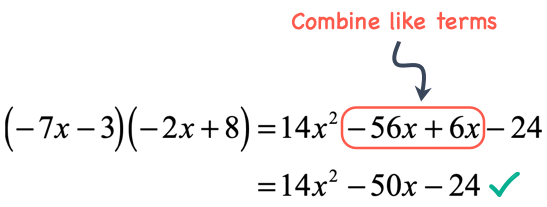
Example 5: Multiply the binomials [latex]\left( { – \,x – 1} \right)\left( { – \,x + 1} \right)[/latex].
Solution:
- Multiply the first terms
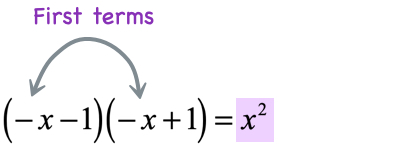
- Multiply the outer terms
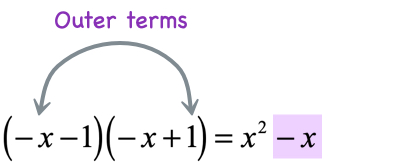
- Multiply the inner terms
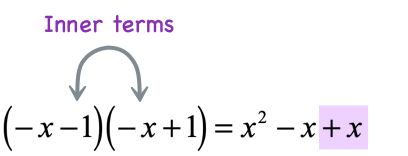
- Multiply the last terms
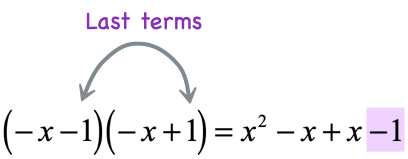
Notice that the middle two terms cancel each other out!

Example 6: Multiply the binomials [latex]\left( {6x + 5} \right)\left( {5x + 3} \right)[/latex].
Solution:
- Product of the first terms

- Product of the outer terms

- Product of the inner terms

- Product of the last terms

Add the two middle [latex]x[/latex]-terms, and we are done!
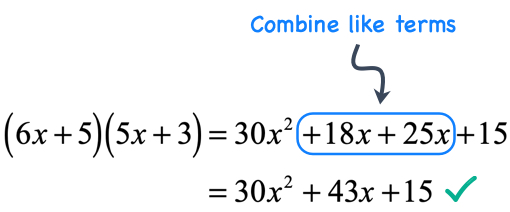
Example 7: Multiply the binomials [latex]\left( {x – 12} \right)\left( {2x + 1} \right)[/latex].
Solution:
- Product of the first terms
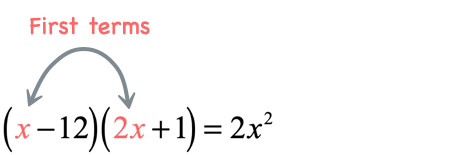
- Product of the outer terms
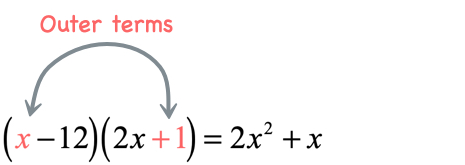
- Product of the inner terms

- Product of the last terms

After expanding the binomials, combine like terms to get the final answer!
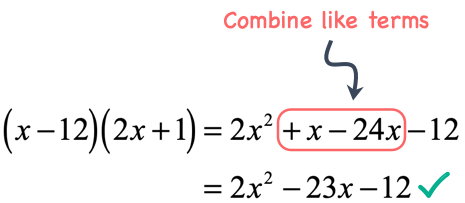
Example 8: Multiply the binomials [latex]\left( { – \,10x – 6} \right)\left( {4x – 7} \right)[/latex].
Solution:
- Multiply the first terms

- Multiply the outer terms

- Multiply the inner terms

- Multiply the last terms

After distributing the terms of the two binomials using the FOIL method, combine like terms to get the final answer.
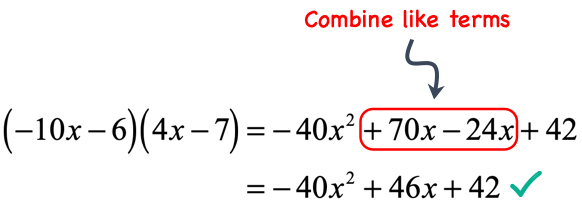
You may also be interested in these related math lessons or tutorials:
Adding and Subtracting Polynomials
Dividing Polynomials using Long Division Method
Dividing Polynomials using Synthetic Division Method
Multiplying Polynomials
